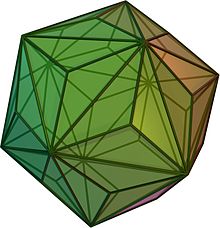Kotzig's theorem

In
More generally, every planar graph of minimum degree at least three either has an edge of total degree at most 12, or at least 60 edges that (like the edges in the triakis icosahedron) connect vertices of degrees 3 and 10.[4] If all triangular faces of a polyhedron are vertex-disjoint, there exists an edge with smaller total degree, at most eight.[5] Generalizations of the theorem are also known for graph embeddings onto surfaces with higher genus.[6]
The theorem cannot be generalized to all planar graphs, as the complete bipartite graphs and have edges with unbounded total degree. However, for planar graphs with vertices of degree lower than three, variants of the theorem have been proven, showing that either there is an edge of bounded total degree or some other special kind of subgraph.[7]


